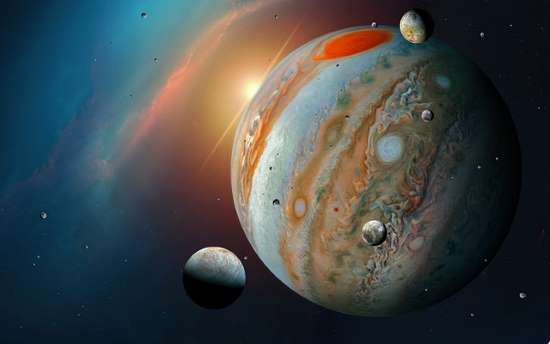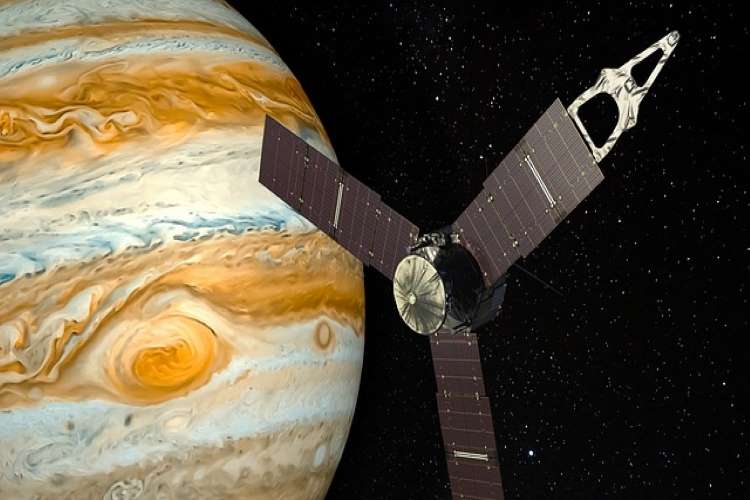Jupiter, also known as the “King of the Planets,” is the largest planet in the solar system. It’s a massive gas giant composed up of hydrogen. When all of the planets in the solar system are put together, Jupiter is still around twice as large.
The pressure deep inside the planet, under the gas, is so high that hydrogen turns into a vapour and then metal. Under Hydrogen, there is a rocky nucleus approximately the size of the planet Earth.
Jupiter rotates fastest, despite its size. It takes just 10 hours to complete one rotation. It turns so hard that the equator bulges slightly, and the clouds are drawn into dense bands. There are even more cool facts about Jupiter for kids.
Also Read: 12 Amazing & Interesting Facts about Space: Facts Every Kid Should Know
H2. Weather on Jupiter
Jupiter’s cloudy atmosphere is about 1000 kilometers (600 miles) thick, but there is no stable crust under the clouds. On the inside, they swirl over a liquid layer of hydrogen and helium. Jupiter’s bands are the product of different molecules in the planet’s atmosphere merging and accelerating as it spins.
Over Jupiter’s surface, massive hurricane-like hurricanes, waves, thunder, and lightning rage. Jupiter’s Great Red Spot, a storm, is three times the height and half the circumference of Earth. Its spinning mass, which has been observed since 1666, takes around a week to transform anti-clockwise.
The Great Red Spot is about 8 kilometers above the clouds and drops about 8 kilometers above the clouds. In the Great Red Spot, winds can exceed 400 km/h (250 mph). Let’s look over some interesting facts about Jupiter for kids.
Also Read: Interesting Science Facts for Students: Compelling Science Facts that will Intrigue Children
Interesting and Cool Facts about Jupiter for Kids
Jupiter is a planet named after the supreme Roman deity. He was known to the ancient Greeks as Zeus, the Greek gods’ king, and Mount Olympus. It resembles a star, but it never became large enough to begin the fire. Swirling cloud streaks adorn the surface.

- Jupiter is the largest planet in our Solar System and the sixth planet from the Sun. It is thought to be a falling star and it is made up of spinning molecules and liquids that are 90% hydrogen and 10% helium, somewhat close to the Sun.
- The gaseous shell – Jupiter’s atmosphere – is the Solar System’s main planetary atmosphere. It covers almost the whole globe. Its atmosphere reaches altitudes of 5.000 km / 1.864 mi, but it doesn’t have a real surface.
- Jupiter has 79 confirmed moons in all. When it comes to the highest number of satellites, it is just second to Saturn.
- Jupiter’s auroras are the brightest in the Solar System, even though they can only be observed by ultraviolet.
- Jupiter has about twice the mass of all the planets in the Solar System combined. It has 318 times the mass of Earth.
- Jupiter is hit by 200 times as many asteroids and comets as Earth.
- Jupiter is one of the five visible planets and the fourth brightest star in the sky ( Mercury, Venus, Mars, Saturn ).
- The discovery of the four Galilean moons by Jupiter’s observations put an end to the idea that everything revolved around the Earth.
- Jupiter has three-ring systems as well, but they are much smaller than Saturn’s.
- Jupiter’sdiameter is approximately 142.984 kilometers at the equator and 133.708 kilometers at the poles. The entire circumference of 69.911 kilometers.
- Jupiter is around 5.2 AU from the Sun on average. One AU equals 150 million kilometers / 93 million miles.
- Because of its strong gravity, Jupiter serves as a vacuum cleaner for the Solar System, attracting more comets and asteroids to collide with it rather than other planets.
- Jupiter is the Solar System’s main planet and the sixth planet from the Sun. It is 318 times larger than Earth, making it more massive than all the other planets combined.
- The ring system that Jupiter has was first seen in images captured by the Voyager1 space probe in 1979. The rings were formed by dust kicked up when meteorites have hit Jupiter’s four inner moons.
Also Read: Fun Facts About Space For Kids: Explore the Unexplored Space for Kids at the Right Place!
Facts about Jupiter’s Moons for Kids
Jupiter has 63 known moons, with several more that are yet to be discovered. The majority of them are small and black in colour. Scientists conclude that all of them are asteroids caught in Jupiter’s enormous gravity.
Europa, Ganymede, and Callisto are the names of Jupiter’s main moons, the Galileon moons. Voyager 1 discovered that one of its moons, Io, has volcanoes that are so active that their crust is continually being broken up.
A German astronomer called Simon Marius coined the names of the four main moons. In 1610, they were studied by Galileo Galilei, who initially mistook them for small stars. They can be seen from Earth with good binoculars.
- The ice surface of Europa is crisscrossed with lines that indicate deeper activity. According to scientists, the ice could surround a liquid-salty ocean with the potential for marine life. It has always been the most likely site for extraterrestrial life in our solar system. There are no red stripes on it!
- Ganymede is heavier than Mercury, but it does not orbit the sun, because it is not a planet. This moon is thought to have a molten core covered by a rocky mantle, perhaps salt water, and an ice cap, according to scientists. It is our solar system’s largest known moon.
- Io’s surface is regularly experiencing volcanic eruptions, which gives it an amazing yellow-orange colour. There are over 100 active volcanoes in the region! Since this moon is constantly tugged and pulled along by the gravitational pulls of the other three, eruptions occur. Io’s volcanoes throw the debris a long way into space.
- The bleak and filthy ice shell of Callisto is riddled with craters. Valhalla, the biggest, has shock waves that extend over 3000 kilometers (1865 miles). According to astronomy, the crust may hide a rocky core. It has been severely damaged by thousands of meteorite impacts.
Also Read: Interesting and Amazing Facts about Moon: Fun Facts about Your Kid’s Night Friend
Conclusion
Jupiter’s powerful magnetic field is believed to play a role in shielding Earth from a greater meteorite bombardment. When meteorites approach the solar system from the outer reaches, Jupiter intercepts them before they can get close to Earth.
Jupiter has been researched for several years, with Galileo Galilei’s first discoveries reported in 1610. Since then, we’ve sent a slew of satellites, probes, and orbiters to Jupiter to gather data and take precise photographs. To know more about your kid, you should look over some space facts for children and be thorough with your general knowledge.
If you have any further concerns, please leave them in the comments section below. Also, take a look at our other posts.







